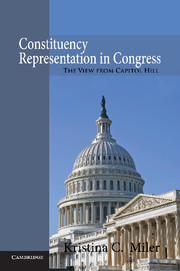Book contents
- Frontmatter
- Contents
- Acknowledgments
- 1 The Unanswered Question of Legislative Perceptions
- 2 A Dyadic Theory of Subconstituency Representation
- 3 The Psychology of Constituency Representation
- 4 Subconstituents Relevant to Health Policy and Natural Resources Policy
- 5 Explaining Legislative Perceptions
- 6 The Effects of Legislative Perception on Participation
- 7 Reassembling the District as a Whole
- 8 Perception, Reform, and Representation in Congress
- Appendix A Sampling
- Appendix B Interviews
- Appendix C Measurement of Primary Independent Variables
- Appendix D Measurement of Legislative Participation
- Appendix E Instrumental Variables Model of Legislative Participation
- References
- Index
5 - Explaining Legislative Perceptions
Published online by Cambridge University Press: 05 October 2010
- Frontmatter
- Contents
- Acknowledgments
- 1 The Unanswered Question of Legislative Perceptions
- 2 A Dyadic Theory of Subconstituency Representation
- 3 The Psychology of Constituency Representation
- 4 Subconstituents Relevant to Health Policy and Natural Resources Policy
- 5 Explaining Legislative Perceptions
- 6 The Effects of Legislative Perception on Participation
- 7 Reassembling the District as a Whole
- 8 Perception, Reform, and Representation in Congress
- Appendix A Sampling
- Appendix B Interviews
- Appendix C Measurement of Primary Independent Variables
- Appendix D Measurement of Legislative Participation
- Appendix E Instrumental Variables Model of Legislative Participation
- References
- Index
Summary
The preceding chapters reveal that legislative enterprises are responsible for representing districts made up of many subconstituencies that vary according to the policy at hand. Yet we know remarkably little about where a legislator's sense of his constituency comes from. Dexter (1957, 2, italics added) calls attention to the origins of perceptions of the constituency and writes, “The fact is the congressman represents his image of the district or of his constituents (or fails to represent his, or our, image of them). How does he get this image? Where does it come from?”
This chapter is motivated by Dexter's observation that scholars know little about the origins of legislators' images of their district. Consequently, the factors that determine which constituents a legislative enterprise sees, and the reasons why one congressional enterprise sees a subconstituency but other legislators do not, remain unknown. Consider the case of the national energy bill, where for every three legislative offices who perceived the interests of environmentalists in energy policy, two offices did not see the environmental subconstituency in their district as relevant to the bill. Similarly, in the case of the Patients' Bill of Rights, only a slim majority of legislative offices perceived patients' interests despite the fact that every congressional district includes patients enrolled in managed care programs. In fact, across the four policies examined, not a single subconstituency was perceived by all legislative enterprises.
- Type
- Chapter
- Information
- Constituency Representation in CongressThe View from Capitol Hill, pp. 76 - 103Publisher: Cambridge University PressPrint publication year: 2010



